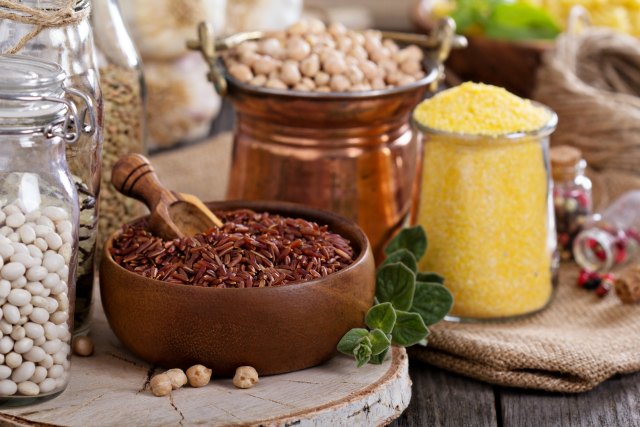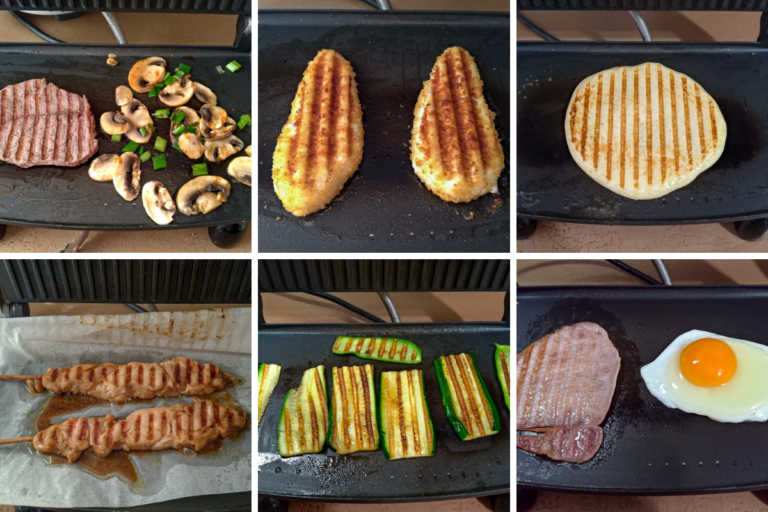6 Things You Need To Do To Save Money On Meat
This website may earn commissions from purchases made through links in this post.
Unless you’re vegetarian, meat can be the most expensive item on the grocery list. Here are some ideas on how to save money on meat and eat healthy at the same time.

Meat can be really expensive – often the most expensive item on the grocery list.
And the prices seem to be going up and up.
So what’s an omnivore to do?
Below are 6 ways to save money when buying meat plus the five-step solution that our grandparents used to maximise their meat budget back when meat was a lot less abundant.
6 Ways to Save Money on Meat
The more of the following tips you employ each week, the more money you’ll save on meat.
1. Eat Less Meat
The meat lovers of the world might groan at this suggestion (and full disclosure, my family – including me – eats meat), but there’s a good reason for eating less meat, and it’s not just to save money.
Many nutritionists agree that eating less meat is healthier. Even many Paleo enthusiasts emphasise fresh vegetables over meat.
Meat consumption has dramatically increased over the past 100 years. Never in history have individuals (at least in wealthy nations) had the luxury of eating so much meat each week. And that increase in consumption is at the expense of the environment and animal welfare.
There are two ways to cut down on your meat consumption:
- Eat more vegetarian meals per week
- Reduce the size of your meat portions when eating meat (this is a good way to still enjoy more expensive cuts occasionally)
A healthy person needs about 0.8g of protein per kilo of body weight for the average person.
To give you an idea of what that looks like, you get about 26 grams of protein in a 100g steak.
That’s about the size of your palm!
Most of us consume two to two and a half times the amount of protein we need each day. And it’s possible to get enough protein from plant sources alone.
But what if you or someone in your family is a dedicated carnivore and vegetarian meals just won’t cut the English mustard?
Start your vegetarian adventure with hearty, robust vegetarian meals so you don’t feel like you’re missing out on meat. Hearty mushroom pasta is a good example of a robust vegetarian meal. Don’t start at the tofu and quinoa end of the spectrum, or you lose your family before you even begin.
Some of our favourite frugal vegetarian dishes include:
- Clear out the crisper curry
- Roast vegetable frittata
- Vegetarian nachos (my meat-loving husband says these are better than the meat version!)
- Vegetable fritters
You might also like: How to Stretch Your Meat Budget by Using Meat for Flavour
2. RELISH THE CHEAPER CUTS OF MEAT
Every cuisine around the world has a strong peasant tradition that takes the cheaper cuts of meat and turns them into something amazing.
Think Boeuf Bourguignon. You can’t get more fancy pants than that, but it uses cheap stewing steak. The long stewing time turns the tough (but tasty) cut into a mouth-wateringly tender masterpiece.
And there lies the other benefit of cheaper cuts of meat: slow cooking. Not only do you save money, but you also save time! Come home to a meal that’s bubbled away in your slow cooker while you’ve been out.
Cheap meat cuts include:
Beef
- Neck
- Chuck / Blade
- Brisket
- Shin
- Leg
- Skirt / Flank
Lamb
- Scrag / Neck
- Breast
- Shank
Pork
- Belly
- Shoulder
Chicken
- Drumstick
- Wing
- Whole Chook
Other
- Mince
- Sausages
- Bacon
- Offal
Slow-cooked cuts:
- Lamb neck stew (one of the most popular recipes on the blog and one of my favourite!)
- Old fashioned beef pie
- Slow-cooked pulled pork shoulder
3. STRETCH MEAT WITH CARBS AND VEGETABLES
Make meat go further by bulking it up with fillers. For example, meat rissoles can go further if you add grated vegetables to them (and you’re sneaking in more vegetables). You can even add some cooked lentils – no one will ever know.
By bulking out your meat with ‘hidden’ ingredients, you can feed two, three or more people with a small amount of meat.
You can also cook meat stretcher meals where a little bit of meat goes a long way. A curry, stir fry pasta dish or risotto are good examples. For each of these dishes you use lots of vegetables, serve on a bed of rice, noodles or pasta with a delicious sauce and just a little bit of thinly sliced meat.
Here are some meat stretcher meal ideas:
- Best ever rissoles
- Chilli Beef
- Chicken and asparagus risotto
- Tuna casserole
- 1 Breast chicken pie
- Mince bake
- Sausage, bean and vegetable stew
- Spaghetti bolognese
- Leftover chicken burritos
- Leftover chicken and pea pasta
- Pulled pork enchiladas
4. BUY MARKDOWN MEAT AND SPECIALS
Meat marked down because it’s close to it’s used by date can be a great way to save. You can freeze this meat indefinitely, you just have to cook and eat it the day you defrost it.
Sunday afternoons and Monday mornings (not too early) are good times to look for marked down meat, but keep an eye on when your store tends to mark their meat down. Stores that have less foot traffic often have better markdowns and I’ve found IGA have bigger markdowns than the big stores when it comes to meat.
Specials are also a good time to stock up and save.
You might also like: How to Eat Well on an Extremely Tight Budget
5. BUY IN BULK AND SAVE
You can often get a bargain by buying in bulk, especially if you’re lucky enough to have access to a wholesale meat seller.
Take the time to make note of the price per kilo of your favourite cuts of meat and then go and compare them to a butcher shop, preferably one that is not in the main shopping centre where rents are high and prices reflect the rent. Or compare with an Aldi if you have one.
When you find a great bargain, buy up big and freeze for later. I keep a little cash envelope where I squirrel away a couple of dollars each payday especially for bulk meat buying. If I find a bargain, I’ve got some cash ready to make the most of it!
Then, when you get home, divide your meat up into meal-size portions and freeze. Taking the time now to prep your meat will save you time on the night when everyone’s hungry and you don’t feel like cooking.
For instance, slice your meat before you freeze it for an easy stir-fry. Then all you have to do is throw it in the wok with some fresh or frozen vegetables and your favourite flavours or sauce, and you’ve got a healthy, easy meal in minutes.
Another idea is to place your drumsticks in a ziplock bag, add the marinade, give it all a squish around and freeze them in the marinade. When it comes time to cook, you just have to tip the drumsticks into a baking dish and dinner is prepped!
Just be sure to label everything well before you freeze it. Everything looks the same once frozen.
Read further: Save time in the kitchen with the cook once, eat twice menu plan
6. MAKE THE MOST OF EVERY MORSEL
I’m not suggesting you should cook sheep’s head stew (although I have a nice recipe for it). But we waste so much of the animal, favouring a few choice, plastic-wrapped cuts.
Reduce waste and save money by eating the ‘other bits’. Offal is some of the most nutrient-dense foods you can eat. And there’s nothing like a good steak and kidney pie on a cold winter’s night or a lamb’s fry and bacon.
If you’re shaking your head and thinking “Melissa, there ain’t no way, girlfriend,” (that’s exactly what friend would say), then make stock from the bones. Homemade stock (or ‘bone broth’ for the in-crowd), is nutritious, versatile and practically free.
If you want to make stock, this method in the slow cooker is by far the easiest and cheapest way to do it.
THE 5 STEPS THAT OUR GRANDPARENTS USED TO SAVE ON MEAT
This is my favourite way to save on meat and it’s how our grandmothers used to do it.
- Find a cheap roast cut like a shoulder roast marked down or on sale.
- Slow roast the meat and serve with lots of vegetables.
- Shred and portion the leftover meat to use in meat stretcher meals to make that roast go as far as it can (and if you can stomach offal, add it to these meat stretching meals).
- Use any offcuts of fat to cook with.
- Make stock from the bones for soups, stews, risotto, gravy etc. Keep some aside to make gravy for the next roast.
The best way to save on meat? Become a vegetarian. But if that’s not an option for you (and we aren’t vegetarians) then these 6 tips will help you stay on top of your meat budget.








Hi Melissa
This is a classic tip. It is very very good that you put them in this nice blog post.
I myself do all of them (except the offals) to ensure we eat healthily on a healthy budget.
I try to do the groceries in 1 lot, too, to ensure we stick to our grocery budget. But there will always be extra runs.
For miscellaneous runs, I use coupons I obtained from paid online surveys. I get $450 last 2 months. It helps for buying items out of normal runs, like buying stuffs for buying my snacks in the office, buying things that my normal grocery store does not stock, etc.
I am a new australian personal finance blogger. If you have time, feel free to check my blog out at moneysmartt.blogspot.com.au.
Thank you :)
Thanks, will check out your site!
Have a great day :)
This is a fantastic article, a huge wealth of information right here, one that I’ve book marked for future use. I’m happy to say that we do some of these methods for “stretching” meat and we tend to eat a lot of chicken because of how cost effective it is.
Recently in the Dividends Down Under household we’ve been spending a little more on food in preparation for IVF, we are trying to eat as well as we can (more seeds, fresh fruits, nuts) and have very much noticed the cost of quality low-fat red meat.
Jasmin
Best of luck with the IVF.
I love this blog already! I look forward to reading more. Thanks Melissa!!